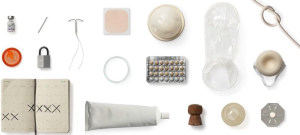Source: Bedsider.org
Ah, yes. Contraception, our old friend. Of the host of considerations taken by sexually active college students throughout the years, it’s remained one of the most frustrating, yet important pre-coitus precautions. With so many young, ambitious, libido-charged individuals all in one place, it’s imperative you and your partner strike a balance between enjoyment and protection. There are plenty of stressors awaiting you (sorry), but safe sex shouldn’t be one of them. More pointedly, I’d venture that an unexpected pregnancy at this stage in your life – whether it’s you or your partner – isn’t so ideal. Here’s where contraception comes in.
It often seems as though the pharmaceutical industry is deliberately attempting to flummox us with the myriad options out there. The flowery-synchronized- swimmer-commercial trope of “Which birth control is right for me?” is tired. But with a little digging, it’s a question with a unique answer for all of us, no matter our gender (Roger that: men included). In short, I’m going to try and make the question of contraception a little easier. Here are a handful of the best options out there, as well as a few resources to aid you in your quest to avoid buns in the oven, minus the actual bread kind.
- The Condom 4.0 stars
Pros: Old Faithful. There’s a reason they’ve been around so long (the 16 th century, in fact). They’re the package deal: birth control and effective protection against most STIs all in one. In fact, they’re the only method of protecting against STIs, aside from abstinence. Therefore, the condom is an excellent complement to all other forms of birth control. This stretchy little guy acts as barrier contraception, meaning there are no hormones at play here, just a wall. It’s also the easiest existing option for guys to get involved in contraception. Cabbage patch/running man/dance in some other form for equality!
Cons: Condoms are thin. Translation: they can break. So be careful. Don’t buy unlubricated. Also, you have to know how to put them on properly. Check this link for details. Finally, some (guys in particular) complain that sex doesn’t feel quite the same with a condom. However, that’s a pretty small sacrifice to prevent pregnancy and STI transmission, so I’d say you can probably cut your very small losses and go for the condom.
- The Pill 4.0 stars
Pros: Indubitably the most common and one of the most effective methods of female-only birth control. There are plenty of brands to choose from as well as a variety of hormone levels that your doctor (or a free clinic/Planned Parenthood!) can help determine to suit your personal needs. Many different types of insurance cover birth control with $0 copay, so look into that as well. When taken properly*, the pill is up to 99.9% effective, meaning the odds are very much in your favor. Additionally, it can reduce or even relieve many PMS symptoms, and some women can stop getting their period altogether.
Cons: And here we come to the little *. The pill needs to be taken every day, at the same time. It’s great if you have a perfectly regulated schedule or remember to carry it around with you so as to take it at the same time no matter what, but on the other hand, we’re human. We forget things. The pill is still quite effective even when you don’t remember to take it at the same time, but less and less as your consistency wavers. Progestin and estrogen pills are more forgiving, while progestin-only pills must be taken at the same time every day in order to consider yourself protected. The pill comes in monthly or 3-week packs, and typically the prescription needs to be re-upped by the signing doctor every 12 months. Additionally, the pill can react adversely to your body depending on the hormone dosage and whether it’s a progestin and estrogen or just progestin pill. Make sure you have a thorough talk with the prescribing doctor to find a pill that fits you.
- The IUD 4.5 stars
Pros: Once it’s inserted and settled properly, the IUD is there. No sweat, and it’s over 99% effective. There are a few hormonal (Mirena being the most common) and non-hormonal (the copper IUD ParaGard) options available, with efficacies ranging from 3-12 years. Though you should still use a condom to prevent STIs (as with all other forms of contraception), the IUD is incredibly comfortable, safe, effective, and low-maintenance. IUDs are also an excellent alternative for women who have side effects from the hormones in the oral pill, as the IUD’s work happens locally in the uterus, as opposed to through hormones that must first travel through the bloodstream. Some women also may stop menstruating with the IUD, which many consider a benefit. The insertion does not require any anesthetic and usually only takes about 10 minutes or so to complete the procedure. The same goes for the removal of the IUD after the allotted number of years. As with the pill, many insurances will partially or fully cover the cost of the IUD.
Cons: There’s a process of insertion with the IUD, which is very brief yet fairly uncomfortable. It involves inserting the tiny T-shaped plastic IUD through the cervix opening and into the uterus, which can cause some fairly severe cramping during insertion. After the procedure, most will experience some very mild cramping and possibly some spotting for a day or two, which can be remedied with ibuprofen and hot compresses. The copper IUD often results in increased period bleeding for the first few months up to a year, unlike the hormonal IUD. Finally, there are rare cases in which the IUD shifts in the uterus, to the point of being expelled or perforating the uterine wall. Again, these situations are rare and will be noticeably painful, in which case you can go to the doctor who inserted it to have it removed. Occasionally the nylon strings (which hang just outside of the cervix to aid in removal of the IUD) can be felt by a partner. If this becomes an issue, you can also go to your doctor to have the strings trimmed.
- The Implant 4.5 stars
Pros: The implant, as you can probably gather from the name, is similarly inserted into the body, like the IUD. A local anesthetic is used, and the procedure is similarly very brief, but with less pain. Unlike the IUD, it’s placed under the skin in your arm, but don’t worry about unsightly scars or a bump: it’s almost impossible to see or feel. It is a tiny piece of plastic (roughly the size of a small match) that releases hormones to prevent pregnancy with over 99% efficacy for up to 4 years. Again, you’re free of concern about remembering pills or inserting and removing something like a NuvaRing on a regular basis. Also, your partner won’t have any issue with feeling the implant during intercourse. Many insurance companies will partially or fully cover the implant.
Cons: The implant can cause very irregular and/or heavier periods for up to a year after insertion. However, many women experience the opposite, so it depends entirely on your body’s reaction to non-local hormones (like with the pill). Obviously, it does involve a mild surgical procedure and therefore isn’t entirely painless, and also requires a doctor to remove it. … And male contraceptive efforts? Just condoms for now, but the long-awaited male birth control pill may be on the horizon. That’ll be the dawn of a new day, that’s for sure. This is of course just a brief and sweeping overview of some of the options that are available to men and women today. Consult with a medical professional prior to any sort of contraceptive efforts to ensure that you follow the course of action that is right for you. Before doing so, I would recommend visiting https://bedsider.org/ for a very comprehensive look at all the birth control options available today.
Stay safe and have fun, kids!








